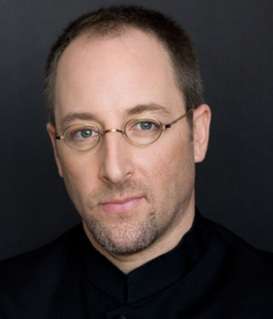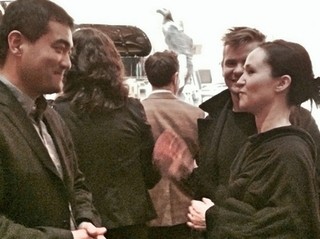|
Back
Enigmatic Variations New York
Grace Rainey Rogers Auditorium, Metropolitan Museum of Art
06/05/2015 -
Tōru Takemitsu: Archipelago S. for 21 Players
Dai Fujikura: Infinite String (World Premiere)
Misato Mochizuki: Si bleu, si calme (U.S. Premiere)
Olivier Messiaen: Sept Haïkaï
Stephen Gosling (Piano)
Members of the New York Philharmonic Orchestra, Jeffrey Milarsky (Conductor)

J. Milarsky (© Juilliard School)
“Quite often people say they are proud to be from somewhere. I don’t understand: where you are from is not up to you.”
Composer Dai Fujikura
Visiting Japan numerous times while living in Asia, I inevitably felt locked in front of glazed opaque doors. Part was ignorance of the language, of course. More important was that the country seemed a mass of interlocked paradoxes. Those childishly simple shrines with cases of saké were connected to stones dating back the Sun-God five-thousand years ago. The cruddy muddy village lanes opened to rooms with each object so perfectly situated it could be nowhere else. Musicians orchestras of the most profound understanding, could go into a bar and become slobberingly drunk in three minutes.
Following Seiji Ozawa around Hong Kong for a story, I couldn’t believe how crass, almost crude he was–and then he conducted Bartók’s Miraculous Mandarin (and a few years later, a week of Berlioz) with the most delicate of batons. And interviewing a bored Toshiro Mufine, I was stunned, after one innocent question, he suddenly spoke non-stop about religion and magic, for 20 minutes.
No matter how many adventures, stories, characters, sites I encountered from winter snows to summer festivities, I always came back feeling that this was a country I could never understand. And last night, I discovered another puzzle of Japan, with the New York Philharmonic’s new-music series, “Contact!”
It started with Tōru Takemitsu, supposedly that “most Japanese” composer, who confessed to having “discovered” Japanese music long after he had become an international star. It continued with Dai Fujikura, who left for London at the age of 15, and confessed, “I think of my nationality as absolutely nothing. On so many levels.” And that splendid French-residing composer Misato Mochizuki, who is inspired by “scientific thinking about nature and its mysteries.”
(And perhaps only an artist of her quality can put “science” and “mystery” in the same sentence.)
Ironically, the most “Japanese” music of the evening was provided by Olivier Messiaen and his Seven Haiku

D. Fujikura/A. Thorvaldsdóttir
(© Gail Wein/Classical Communications)
The concert was a celebration of sorts, including the introduction of Anna Thorvaldsdóttir, the young Icelandic composer who was appointed the Kravis Emerging Composer for the Philharmonic. Her meeting in the intermission with Dai Fujikura was an obvious meeting of true minds, since they are both representatives of their countries–yet, as artists, supersede the notion of nationalism.
Mr. Fujikura, while eschewing any idea of nationalism, is a fervent and brilliant exponent of genesis. His Mina was inspired by the birth of his child Mina, and is a set of lullabies and wondrous sounds for this child. But the most brilliant of his pieces was Joule, a remarkable piano work played by Taka Kigawa and an ensemble, filled with energy, pointed polyrhythms and syncopations leading to advanced jazz.
Equally remarkable was last night’s Infinite String (New York Philharmonic commission), for divided strings celebrating the life inside the womb. I found no way to separate the weeks and months of gestation, but it started with a startling series of chords and sounds of the original cell, multiplying, replicating. Not themes, but motifs grew, evolved, changed, became different themes. At times, the 19 strings of the Philharmonic, conducted by the always astute Jeffrey Milarsky (making his belated debut with the orchestra). One would have imagined a kind of crescendo as cell grew to fetus (and ending in an Umbilical Chord?), but no, Mr. Fujikura is too subtle for that and the work had waves of dissonance and consonance, tenderness and sudden tuttis.
Perhaps a more orthodox structure about the evolution of life would have made the work simpler. But Mr. Fujikura is not a simple or orthodox composer, and his art–like birth–speaks for itself.
Misato Mochizuki is another relatively well-known name here, though her element and fame lies in Europe, mainly in France. She is also highly eclectic, and her previous works brought together both Japanese and European instruments.
A few decades ago, the title So Blue, So Calm, would summon up idyllic pictures of the sea, but this quote from Paul Verlaine, created in Ms. Mochizuki an exciting music punctuated by blaring explosions of sound, interrupting a more unsettling composition for the small orchestra.
The “blue”, she states, stands for “the elements of air and water.” The “calm” is for “space and silence.” The air, she seems to say musically” is in constant flow, along with the water. The explosions are not for the poetry of the atmosphere, but the attraction and repulsion of the elements.”
It was hardly innate, even for the most profound reviewer, to know that (in her words), she had “transposed electro-acoustic data-processing methods…metric compression or enlargements.” Ms. Mochizuki has her own voice, and even in this early work, she had transposed her ideas into a brilliant palette.
Two famed composers framed the concert, the most intriguing being Tōru Takemitsu’s strangely named Archipelago S. for 21 Players. The “s” was for Stockholm, Seattle and Japan’s Seto Island. The archipelago was for the spatial sounds of four ensembles spread across the stage.
I would have loved it had Mr. Milarsky spread the ensembles around Grace Rainey Rogers Auditorium, but that was impossible, so one listened to the sounds bouncing off each other. To me, there seemed many a quote from Debussy’s Mer (as well as Faun), yet Takemitsu was too classy for mere quotations. Possibly the DNA of sea-music extends to varied music.

S. Gosling (© American Composers Orchestra)
The final work, Messiaen’s Seven Haiku showed off not only Mr. Milarsky and the sizeable Philharmonic ensemble (minus violas, cellos and basses!), but the wondrous piano of Stephen Gosling. In the Cadenza of the Seven Haiku and the obligatory avian sounds (The Birds of Karuizawa), he demonstrated that ineffable purity of his keyboard. For the other six sections, the clarinet and percussion soloists, the flute and piccolo with the entire ensemble, showed the Frenchman’s sense of paradoxical Japan, far more than the three Japanese composers who preceded him.
Harry Rolnick
|